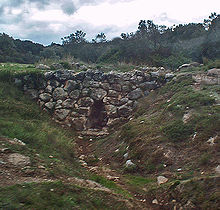Bridge Construction - History
A bridge is a structure built to span physical obstacles without closing the way underneath such as a body of water, valley, or road, for the purpose of providing passage over the obstacle. There are many different designs that each serve a particular purpose and apply to different situations. Designs of bridges vary depending on the function of the bridge, the nature of the terrain where the bridge is constructed and anchored, the material used to make it, and the funds available to build it.
The first bridges made by humans were probably spans of cut wooden logs or planks and eventually stones, using a simple support and crossbeam arrangement. Some early Americans used trees or bamboo poles to cross small caverns or wells to get from one place to another. A common form of lashing sticks, logs, and deciduous branches together involved the use of long reeds or other harvested fibers woven together to form a huge rope capable of binding and holding together the materials used in early bridges.
The Arkadiko Bridge is one of four Mycenaean corbel arch bridges part of a former network of roads, designed to accommodate chariots, between the fort of Tiryns and town of Epidaurus in the Peloponnese, in southern Greece. Dating to the Greek Bronze Age (13th century BC), it is one of the oldest arch bridges still in existence and use. Several intact arched stone bridges from the Hellenistic era can be found in the Peloponnese.
The greatest bridge builders of antiquity were the ancient Romans. The Romans built arch bridges and aqueducts that could stand in conditions that would damage or destroy earlier designs. Some stand today.[4] An example is the Alcántara Bridge, built over the river Tagus, in Spain. The Romans also used cement, which reduced the variation of strength found in natural stone. One type of cement, called pozzolana, consisted of water, lime, sand, and volcanic rock. Brick and mortar bridges were built after the Roman era, as the technology for cement was lost (then later rediscovered).
In India, the Arthashastra treatise by Kautilya mentions the construction of dams and bridges.[6] A Mauryan bridge near Girnar was surveyed by James Princep. The bridge was swept away during a flood, and later repaired by Puspagupta, the chief architect of emperor Chandragupta I.[7] The use of stronger bridges using plaited bamboo and iron chain was visible in India by about the 4th century.[8] A number of bridges, both for military and commercial purposes, were constructed by the Mughal administration in India.
Although large Chinese bridges of wooden construction existed at the time of the Warring States, the oldest surviving stone bridge in China is the Zhaozhou Bridge, built from 595 to 605 AD during the Sui Dynasty. This bridge is also historically significant as it is the world's oldest open-spandrel stone segmental arch bridge. European segmental arch bridges date back to at least the Alconétar Bridge (approximately 2nd century AD), while the enormous Roman era Trajan's Bridge (105 AD) featured open-spandrel segmental arches in wooden construction.
Rope bridges, a simple type of suspension bridge, were used by the Inca civilization in the Andes mountains of South America, just prior to European colonization in the 16th century.
During the 18th century there were many innovations in the design of timber bridges by Hans Ulrich Grubenmann, Johannes Grubenmann, and others. The first book on bridge engineering was written by Hubert Gautier in 1716.
A major breakthrough in bridge technology came with the erection of the Iron Bridge in Shropshire, England in 1779. It used cast iron for the first time as arches to cross the river Severn.
With the Industrial Revolution in the 19th century, truss systems of wrought iron were developed for larger bridges, but iron does not have the tensile strength to support large loads. With the advent of steel, which has a high tensile strength, much larger bridges were built, many using the ideas of Gustave Eiffel.
In 1927 welding pioneer Stefan Bryła designed the first welded road bridge in the world, the Maurzyce Bridge which was later built across the river Słudwia at Maurzyce near Lowicz, Poland in 1929. In 1995, the American Welding Society presented the Historic Welded Structure Award for the bridge to Poland.


0 Comments:
Post a Comment
Subscribe to Post Comments [Atom]
<< Home